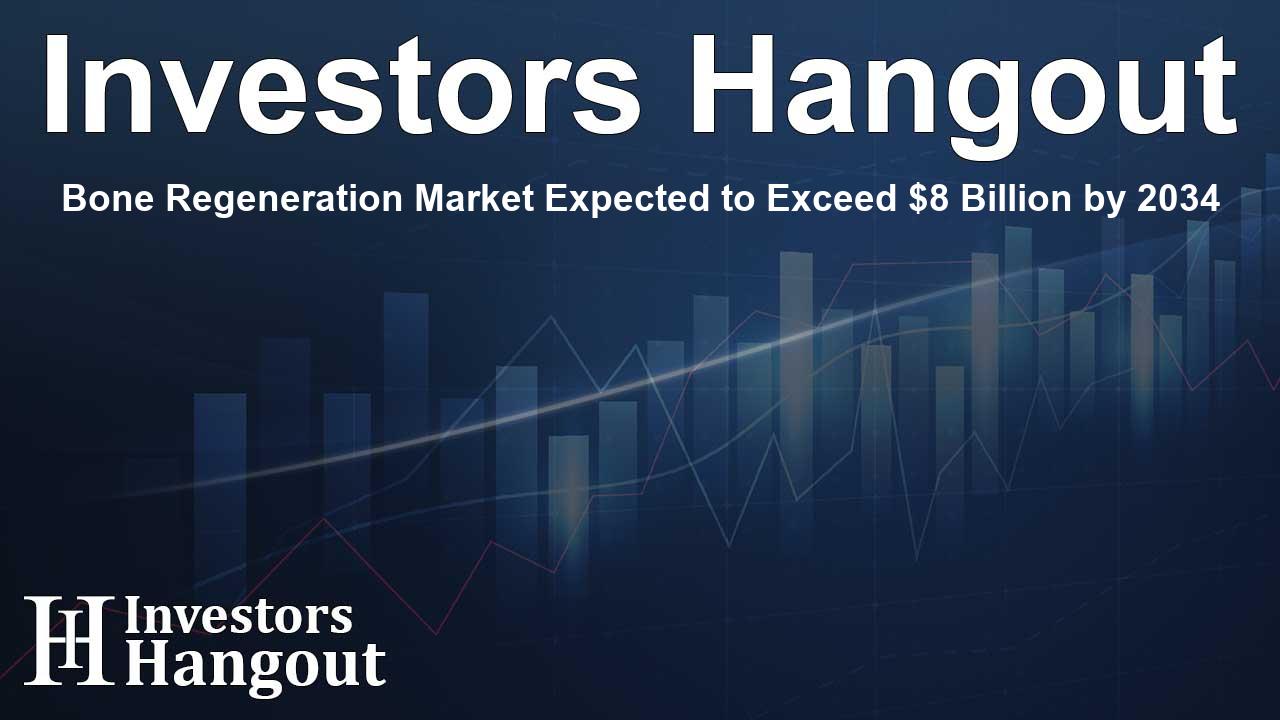Bone Regeneration Market Expected to Exceed $8 Billion by 2034

Understanding Bone Regeneration
Bone regeneration is a natural biological process vital for repairing and replacing damaged bone tissue. This process relies on the activation of osteogenic cells, the development of new blood vessels, and the remodeling of existing bone structure. Effective bone regeneration is essential in healing fractures, performing bone grafts, and other surgical procedures. Recent advancements in tissue engineering and biomaterials are significantly enhancing the efficacy of clinical techniques in this field.
The Market Landscape
Research indicates that the global market for bone regeneration, initially valued at $5.2 billion in 2024, is poised for substantial growth with an expected compound annual growth rate (CAGR) of 4.9% from 2025 to 2034, ultimately reaching approximately $8.4 billion.
This market is primarily driven by the increasing prevalence of bone-related disorders tied to an aging population. Conditions such as osteoporosis, fractures, and bone tumors are increasingly common, necessitating innovative treatment solutions. Additionally, key advancements in biomaterials and regenerative medicine are propelling market growth, as they contribute to more effective patient care and recovery.
Components of the Bone Regeneration Market
The bone regeneration market encompasses a wide range of products and therapeutic approaches. The segment includes various bone grafts, substitutes, and regenerative materials utilized extensively in orthopedic and dental surgeries. Significant developments influencing this market include:
- The growing adoption of synthetic grafts.
- The incorporation of stem cell therapy and 3D bioprinting technologies.
- Increasing demand arising from orthopedic disorders and sports-related injuries.
In addition, regulatory approvals and collaborations among industry leaders are fostering innovation and market growth, enhancing the potential for new treatments to come to market.
Insights on Market Drivers and Challenges
The bone regeneration sector is fueled by factors such as rising orthopedic injury rates among all age groups and significant medical advancements. Additionally, the drive for minimally invasive procedures is leading to increased patient demand for innovative bone regeneration techniques.
While the market has promising growth potential, it faces challenges such as the high costs associated with advanced bone grafting and regenerative therapies, which may limit accessibility to these crucial treatments. Moreover, the stringent regulatory requirements for new bone regeneration products can create delays in approval processes, impacting market entry timelines.
Regional Insights
North America currently leads the global market due to its advanced healthcare systems and high adoption of medical technologies. The prevalence of osteoporosis and other age-related conditions in the aging population plays a vital role in driving the demand for bone regeneration products.
Europe follows closely, spurred by increasing awareness and support for regenerative therapies, while the Asia-Pacific region is emerging as the fastest-growing market segment due to rising healthcare investments and the growing prevalence of orthopedic disorders.
Future Outlook and Opportunities
Looking ahead, the bone regeneration market is ripe for innovation and growth. Opportunities abound, especially in emerging economies where healthcare infrastructure is expanding. Investments in regenerative medicine and research into stem cell therapies are likely to enhance treatment modalities significantly, providing new avenues for care.
Emerging collaborations between research entities and medical companies signify a promising future, potentially leading to groundbreaking advancements in bone regeneration solutions that cater to diverse patient needs.
Frequently Asked Questions
What is the expected market size for bone regeneration by 2034?
The bone regeneration market is projected to reach approximately $8.4 billion by 2034, growing at a CAGR of 4.9% from 2025 to 2034.
What are the key factors driving growth in the bone regeneration market?
Key growth drivers include the rising incidence of orthopedic disorders, increasing awareness of advanced treatment options, and technological advancements in biomaterials.
Which regions are experiencing growth in the bone regeneration market?
North America leads the market, followed closely by Europe and the Asia-Pacific region, which is experiencing the fastest growth.
What challenges does the bone regeneration market face?
Challenges include high costs for advanced therapies, regulatory hurdles, and varying levels of healthcare access across different regions.
How are advancements in technology impacting the bone regeneration industry?
Advancements in technology, such as 3D printing and stem cell therapies, are enhancing the precision and efficacy of bone regeneration treatments, improving patient outcomes significantly.
About The Author
Contact Hannah Lewis privately here. Or send an email with ATTN: Hannah Lewis as the subject to contact@investorshangout.com.
About Investors Hangout
Investors Hangout is a leading online stock forum for financial discussion and learning, offering a wide range of free tools and resources. It draws in traders of all levels, who exchange market knowledge, investigate trading tactics, and keep an eye on industry developments in real time. Featuring financial articles, stock message boards, quotes, charts, company profiles, and live news updates. Through cooperative learning and a wealth of informational resources, it helps users from novices creating their first portfolios to experts honing their techniques. Join Investors Hangout today: https://investorshangout.com/
The content of this article is based on factual, publicly available information and does not represent legal, financial, or investment advice. Investors Hangout does not offer financial advice, and the author is not a licensed financial advisor. Consult a qualified advisor before making any financial or investment decisions based on this article. This article should not be considered advice to purchase, sell, or hold any securities or other investments. If any of the material provided here is inaccurate, please contact us for corrections.
